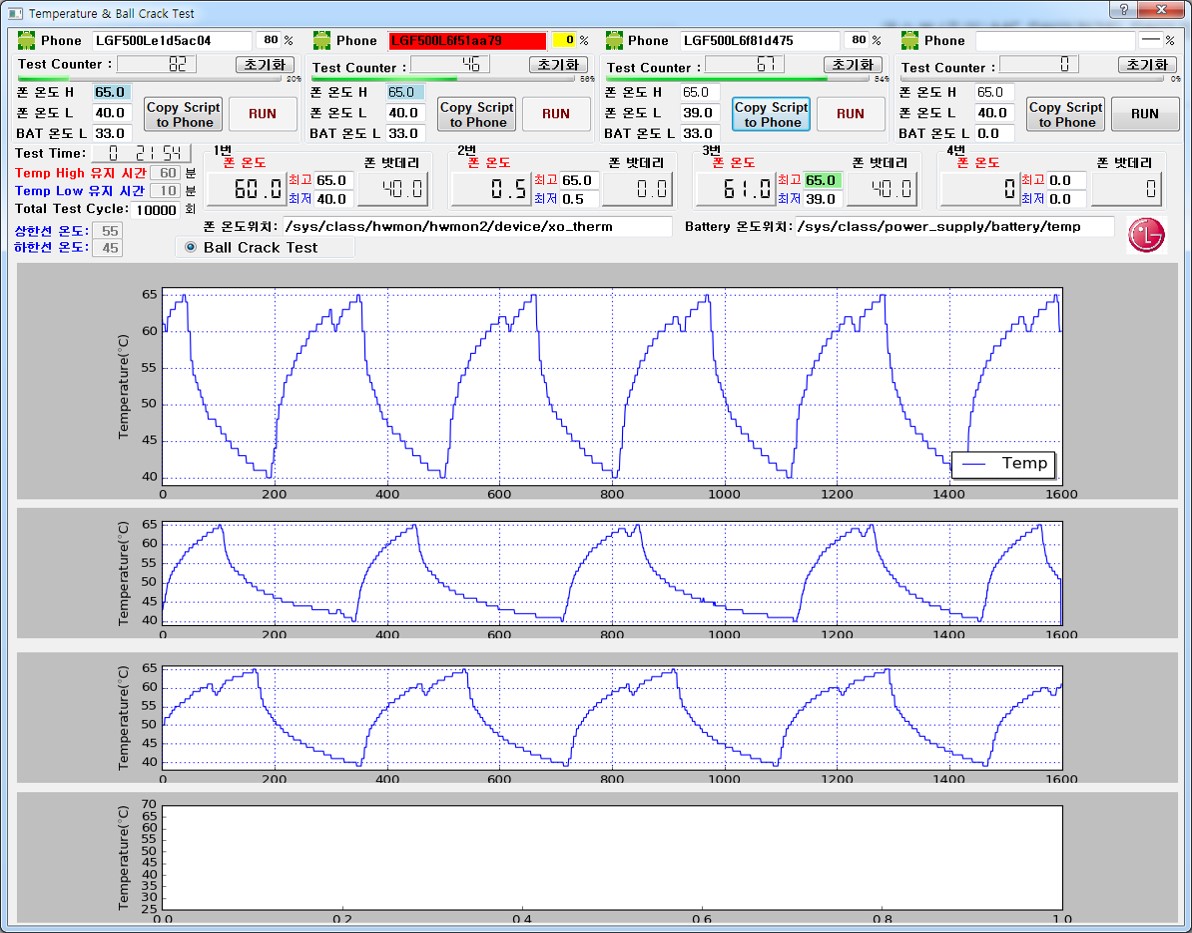This page will describe a Qt5 programming procedure, and show how to use the Qt5 API during making the little project “Temperature Test for Android”
0. Assume that Python 3.5 is already installed at your system.
1. download and install the “Qt 5.7.0 for Windows 64-bit (VS 2015, 918 MB)”
please refer to here here
2. install the pyserial
Anaconda python 3.5 will have it already.
3. install the PyQt5 like below
C:\>pip install PyQt5
Collecting PyQt5
Downloading PyQt5-5.7-cp35-none-win_amd64.whl (68.1MB)
100% |################################| 68.1MB 13kB/s
Collecting sip (from PyQt5)
Downloading sip-4.18.1-cp35-none-win_amd64.whl (46kB)
100% |################################| 51kB 1.7MB/s
Installing collected packages: sip, PyQt5
Successfully installed PyQt5-5.7 sip-4.18.1
please refer to PyQt5 Reference Guide
4. create the UI file of Qt5 using Qt Creator like below image.
5. Qt programming for Android Phone Temperature Test
import and main
from PyQt5.QtWidgets import QDialog, QMessageBox
from PyQt5.QtWidgets import QApplication, QWidget
from PyQt5.QtCore import *
if __name__ == "__main__":
app = QApplication(sys.argv)
myapp = GUIForm()
myapp.show()
app.exec()
#sys.exit(app.exec_())
myapp.Update_data()
GUIForm class, QThread, QTimer, click.connect
class GUIForm(QDialog):
def __init__(self, parent=None):
QWidget.__init__(self,parent)
self.ui = Ui_Dialog()
self.ui.setupUi(self)
self.first_draw_flag = False
# directory name to read temperature
self.path_battery_temp = "/sys/class/power_supply/battery/temp"
self.path_cpu_temp = "/sys/class/thermal/thermal_zone12/temp"
self.path_battery_capacity = "/sys/class/power_supply/battery/capacity"
self.art_script_thread = QThread()
self.get_temp_thread = QThread()
self.myTimer1 = QTimer()
self.myTimer2 = QTimer()
self.myTimer3 = QTimer()
self.myTimer4 = QTimer()
# bind widgets to relative call-back functions
self.ui.pushButton_run_1.clicked.connect(self.Run1)
self.ui.pushButton_run_2.clicked.connect(self.Run2)
self.ui.pushButton_run_3.clicked.connect(self.Run3)
self.ui.pushButton_run_4.clicked.connect(self.Run4)
self.ui.pushButton_copy_script_1.clicked.connect(self.Copy_script_to_Phone1)
self.ui.pushButton_copy_script_2.clicked.connect(self.Copy_script_to_Phone2)
self.ui.pushButton_copy_script_3.clicked.connect(self.Copy_script_to_Phone3)
self.ui.pushButton_copy_script_4.clicked.connect(self.Copy_script_to_Phone4)
self.ui.pushButton_init_1.clicked.connect(self.Init_Totcnt1)
self.ui.pushButton_init_2.clicked.connect(self.Init_Totcnt2)
self.ui.pushButton_init_3.clicked.connect(self.Init_Totcnt3)
self.ui.pushButton_init_4.clicked.connect(self.Init_Totcnt4)
self.ui.Ball_Crack.toggled.connect(self.btnstate1)
# load icon to label
myPixmap = QtGui.QPixmap(os.getcwd() + "/phone.png")
myScaledPixmap = myPixmap.scaled(self.ui.label_9.size(), Qt.KeepAspectRatio)
self.ui.label_9.setPixmap(myScaledPixmap)
font change
def btnstate1(self):
font = QtGui.QFont()
font.setBold(True)
clicking the run button and timer call-back functions
def Run1(self):
if self.equipped[0] == False:
return
myInitParams = 0
timerCallback = functools.partial(self.RunTempTest, myInitParams)
if self.myTimer1.isActive():
print("Timer1 Already Active")
#self.myTimer1.stop()
else:
self.myTimer1.timeout.connect(timerCallback)
self.myTimer1.start(self.periodic_time*1000)
# thread to run the art scripts
self.art_script_thread = ART_Scrtipt(self.device[0], "ART_Temp_Test_Script.py")
self.art_script_thread.start()
call the plot function triggered by timer
def RunTempTest(self, idx):
global g_read_temp_flag
if self.test_result[idx] == False: # Test Error
return
if g_read_temp_flag == True:
self.PlotFunc(idx)
if self.CpuTemp[idx] == 0:
return
QThread running for transfer a ART script
class ART_Scrtipt(QThread): # Power On/Off Thread
def __init__(self, device_id, test_script):
QThread.__init__(self)
self.device_id = device_id
self.test_script = test_script
def run(self):
timestring = time.strftime("%Y-%m-%d %H:%M:%S", time.localtime())
str1 = '[' + timestring + '] '
print("%s Enter Test Script %s !!!" % (str1, self.device_id))
adbcmd.adbcmd(self.device_id, 'am broadcast -a "com.lge.art.ACTION_START_SCRIPT" --es "files" %s ' %(self.test_script))
self.quit()
QThread running for reading temperature from phone
class Get_Temp_from_Phone(QThread): # Power On/Off Thread
def __init__(self, path_battery_temp, path_cpu_temp):
QThread.__init__(self)
self.path_battery_temp = path_battery_temp
self.path_cpu_temp = path_cpu_temp # XO_THERM
def run(self):
global g_device
global g_Cpu_Temp
global g_Bat_Temp
global g_read_temp_flag
# read temperature of a phone
g_Bat_Temp[count] <= value
g_Cpu_Temp[count] <= value
def stop(self):
self.exit_thread = 1
self.quit()
plot the graph with temperature
def PlotFunc(self, idx):
global g_Temp
self.init_data()
if idx == 0:
pointer = self.ui.widget_1.canvas
X_data = self.lstX1
Y_data = self.lstY1
X1_data = self.lstX1_1
Y1_data = self.lstY1_1
pointer.axes.clear()
pointer.axes.set_xlabel('Time(sec)')
pointer.axes.set_ylabel('Temperature($^{\circ}$C)')
pointer.axes.xaxis.set_ticks_position('bottom')
pointer.axes.yaxis.set_ticks_position('left')
#pointer.axes.spines['top'].set_color('red')
pointer.axes.grid(color='b', linewidth=1)
if self.ball_crack_flag == False:
pointer.axes.plot(self.X_upper_limit, self.Y_upper_limit, 'r-', linestyle = '--')
pointer.axes.plot(self.X_center_limit, self.Y_center_limit, 'c', linestyle = '-', label='baseline')
pointer.axes.plot(self.X_bottom_limit, self.Y_bottom_limit, 'r-', linestyle = '--')
else:
pointer.axes.set_ylim(int(self.save_low_temp[idx]-2), int(self.save_high_temp[idx]+2))
pointer.axes.plot(X1_data, Y1_data, 'b-', label='Temp', linewidth=1) # , 'b-', , 'g-' , marker='o'
pointer.draw()

